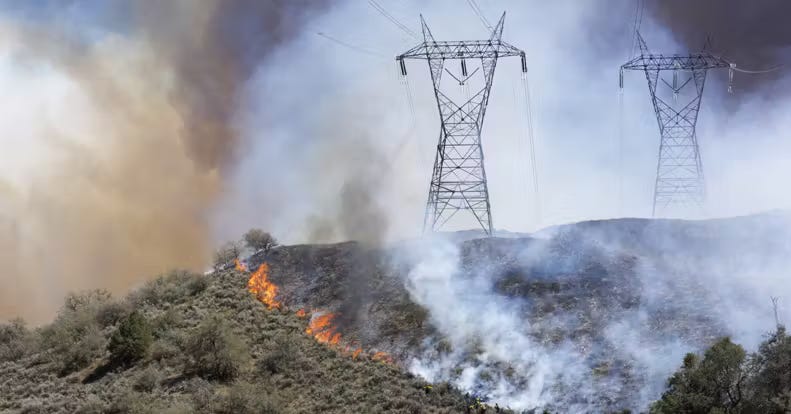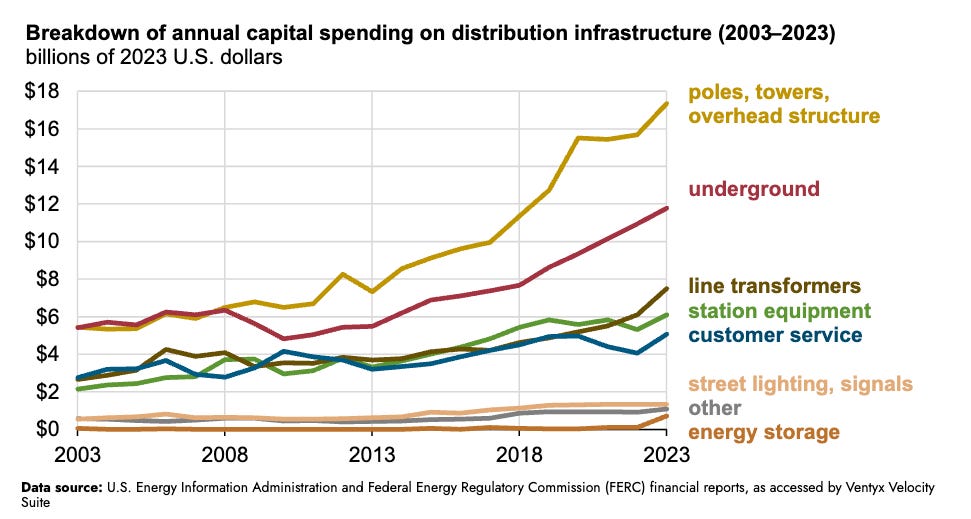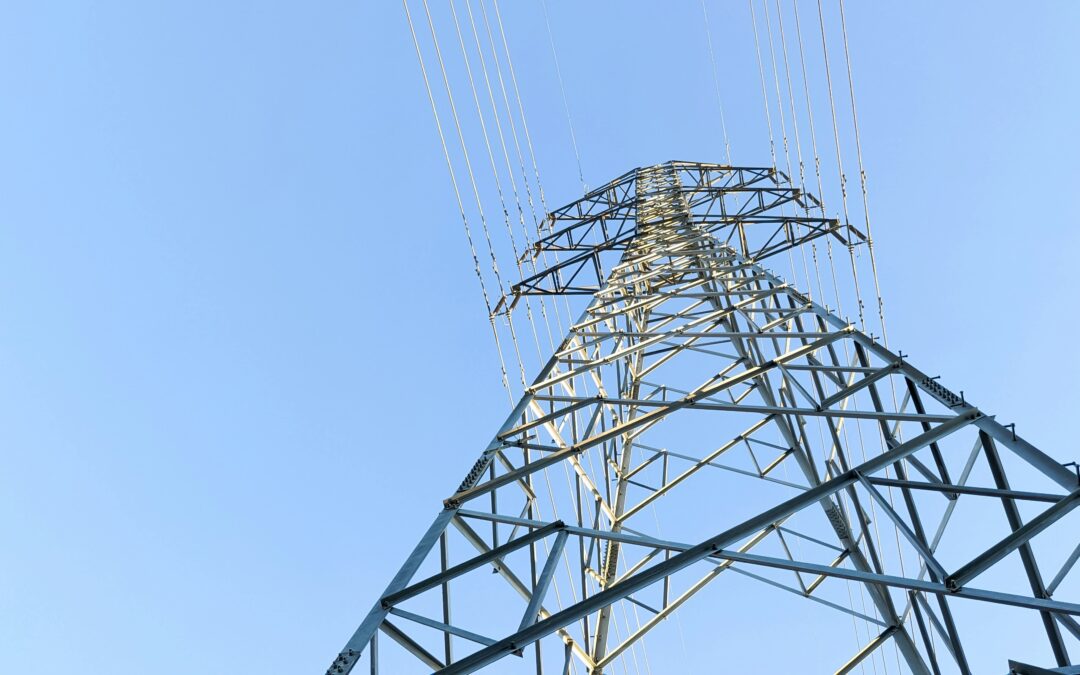The electricity landscape we’ve known for decades is experiencing what we’re calling a “perfect storm” of challenges. After two decades of flat energy demand, we’re witnessing a steep incline that’s colliding with a grid that was largely built in the 1960s and 70s. This isn’t a problem we can solve by simply building more—it’s about fundamentally rethinking how we power America.
America’s Aging Grid
Before we talk about meeting new demand, we need to talk about what’s already happening with the grid. The American Society of Civil Engineers recently gave U.S. energy infrastructure a D+ grade—down from a C- just a few years ago. This represents a $5 trillion problem.
Over 70% of power transformers are more than 25 years old, 60% of circuit breakers are over 30 years old, and 70% of transmission lines are beyond 25 years old. Much of this equipment was built during the post-World War II boom and is now operating well beyond its intended lifespan of 50-80 years.
As of 2017, the depreciated value of the U.S. electric grid sits at roughly between $1.5 and $2 trillion (a more recent analysis hasn’t been conducted by a reputable source). But here’s the gut punch: replacing it would cost nearly $5 trillion. Even maintaining what we have will require hundreds of billions, if not trillions, of dollars over the next decade. And that’s before we talk about expanding capacity for new demand.
The consequences are already visible. Weather-related outages are more than doubling from an average of 109 minutes per year (2013-2015) to 297 minutes per year (2020-2022). These outages cost American businesses an estimated $150 billion annually.
But the aging infrastructure problem goes deeper than just old equipment. The grid was designed for a different era—centralized fossil fuel plants near cities, with power flowing in one direction. Today’s grid needs to handle:
- Distributed renewable generation creating two-way power flows
- Extreme weather events that are more frequent and intense
- Digital loads that require constant, uninterrupted power
- Peak demand patterns that have shifted dramatically with solar adoption

A Huge Shift in Electricity Demand
Now layer the new demand crisis on top of this vulnerable foundation. By 2030, electricity demand in the United States is projected to increase by 25%. By 2050, nearly 80% growth—the biggest expansion since World War II. To put this into perspective, it took us 117 years to build the grid we currently use, and now we’re being asked to essentially double that infrastructure in just 25 years while simultaneously replacing the old infrastructure.
April 2025’s five-year load growth forecast of 120 gigawatts was over five times higher than 2023’s forecast of just 23 gigawatts. The acceleration is pretty astounding.
What’s Driving This Massive Change?
1. AI and Data Centers
There were just 2,600 data centers in the U.S. in 2018. By 2025, that number has exploded to over 5,400 [Source]. These facilities consumed about 17 gigawatts of power in 2022, but by 2030, that demand could reach 35GW, conservatively, or 130 gigawatts, aggressively.
Northern Virginia alone now hosts over 200 data centers—one-third of the world’s total. Dominion Energy has contracts for 40 gigawatts of new load, nearly double what they had just a year ago. The region’s vacancy rates for data center space fell below 1% in 2023, highlighting the frenzied pace of development.
AI workloads are particularly energy-intensive, using up to 10 times the power of standard servers. Training a large AI model can process billions of parameters and vast amounts of data, making it extraordinarily energy-intensive. Even the inference stage—running the models to generate responses—requires substantial continuous power. And these facilities need power 24/7, 365 days a year—no intermittency allowed.
In Texas, ERCOT projects peak demand could hit 218 gigawatts by 2031, up from today’s record of 85 gigawatts. Nearly 78 gigawatts of that growth comes from data centers alone. This is demand growth at a scale Texas has never seen. Over half of the pending data center load nationally is in Texas, where cryptocurrency operations alone are set to add 5 gigawatts.
2. Electrification
The ongoing transition to electric vehicles, heat pumps, and industrial electrification adds layer upon layer of demand. While not as dramatic as AI’s surge, electrification represents sustained, permanent load growth that’s reshaping the traditional load curve. The iconic “duck curve” has been replaced by a “canyon curve”: steep shoulder hours with little reliance on baseload generation during peak renewable hours.
Who Pays?
Residential electricity rates are forecasted to rise between 15% and 40% by 2030, potentially doubling by 2050. Commercial and industrial rates face even steeper increases, potentially up to 75%.
Much of this cost increase isn’t from generating electricity, it’s from delivering it. Analysis of major utilities shows dramatic acceleration in transmission and distribution (T&D) cost growth:
- PG&E (CA): T&D costs grew 5% annually pre-2020, jumped to 15% post-2020
- Southern California Edison: 4% to 10%
- ComEd (IL): 2% to 7%
- Duke Energy Carolinas: 2.5% to 8.5%
In many regions, the cost of delivering electricity now exceeds the cost of the electricity itself.

Utilities are spending record amounts trying to keep up. Capital investment in distribution infrastructure increased by 160% from 2003 to 2023, reaching $50.9 billion in 2023 alone. About 80% of the $186.4 billion spent by U.S. investor-owned utilities in 2024 went to infrastructure upgrades. The Department of Energy estimates that modernizing the grid will cost hundreds of billions of dollars over the next two decades.
Yet even this massive spending isn’t keeping pace with needs. Investment in line transformers increased 23% from 2022 to 2023, partly due to supply chain issues causing replacements to be needed more frequently. Spending on distribution substation equipment has increased 184% since 2003—necessary to help utilities withstand extreme weather, manage renewable intermittency, and allow greater voltage control during emergencies.
The regulator’s dilemma is brutal but the grid desperately needs more investment. How do you balance affordability with the need for a reliable, modern grid? How do you prioritize investments when every dollar comes from ratepayers?
Utilities’ Trade-Offs
The situation gets more complicated from here. Utility strategies will determine whether we build a resilient energy future or stumble through decades of brownouts and rate shock. They are facing decisions with no right solution, forced to choose between competing imperatives while regulators, customers, and shareholders all pull in different directions.
Trade-Off #1: Reliability vs. Decarbonization
The conversation has fundamentally shifted from just a few years ago. Where utilities once focused on decarbonization during a period of flat load growth, the priority matrix has completely flipped. Today, the mandate is unambiguous: reliability first, decarbonization second.
This shift has real, measurable consequences. In Georgia, where demand is projected to increase by 8,200 megawatts by 2030-31 (more than three times the output of the new Vogtle nuclear reactors that cost over $30 billion to build), Georgia Power is requesting permission to extend the life of coal plants that were previously deemed “uneconomic” and slated for retirement. The company even took the unusual step of filing an out-of-cycle integrated resource plan update in 2023, claiming demand was increasing so quickly that they couldn’t wait for the regular planning cycle.
Similar reversals are happening across the country. Utilities in Virginia and West Virginia have proposed delaying coal unit closures. Mississippi Power is keeping a coal plant open beyond its planned retirement to meet data center demand from Georgia.
Data centers need constant, reliable power with no tolerance for interruptions. About 56% of the electricity used by data centers nationwide currently comes from fossil fuels. While renewables are the fastest-growing source of electricity for data centers (with generation increasing at 22% annually), they’re simply not scaling fast enough to meet the surge in near-term demand.
The International Energy Agency projects that between 2024 and 2030, nearly 50% of additional electricity for data centers will come from fossil fuels. Natural gas-fired generation for data centers is growing 1.5 times faster than baseline projections, with the United States seeing the most significant absolute increase. By 2035, fossil fuels are expected to still account for around 35-40% of electricity supplied to data centers across different scenarios.
Trade-Off #2: Speed vs. Cost Optimization
Data centers have development timelines of 18-24 months, compared to federal permitting for a new electric transmission line taking 4 years on average. This fundamental mismatch creates intense pressure for utilities to make rapid decisions that may not be optimal for long-term cost or reliability.
Power unavailability in most markets is driven by limitations in interconnecting to the transmission grid rather than an inability to generate the power itself. This creates perverse incentives. Utilities are making quick deals to serve large loads while cleaner, cheaper alternatives sit in interconnection queues.
Some utilities are pursuing “no-regrets” strategies—prioritizing investments that deliver value regardless of how the future unfolds. These include:
- Replacing old, frequently-failing conductors to reduce maintenance costs
- Upgrading work management systems and scheduling processes
- Installing sensors and smart grid technologies that provide real-time visibility
- Hardening infrastructure against extreme weather events
But even these seemingly obvious investments face challenges. The Federal Energy Regulatory Commission has tried to streamline processes by prioritizing fully permitted projects with land rights and imposing financial penalties for projects that miss milestones. However, progress remains slow, and the gap between data center timelines and grid development timelines continues to widen.
Trade-Off #3: Who Bears the Cost?
This may be the most consequential trade-off. The deals utilities are making with data centers will likely transfer enormous costs to ratepayers.
Data centers get priority interconnection and often negotiate rate structures in exchange for bringing massive, reliable loads. But the infrastructure upgrades needed to serve them—new transmission lines, substation upgrades, grid hardening—typically get socialized across the entire rate base. Customers who derive no direct benefit from the data center end up subsidizing the infrastructure investments through higher rates.
For example, in Georgia, data centers enjoy a sales tax exemption on high-tech equipment, passed in 2018 and renewed with little debate. When Georgia Power extends the life of uneconomic coal plants to serve data center demand, residential customers will pay higher rates while bearing the environmental and health costs of extended coal combustion.
Some utilities are exploring alternative models:
Behind-the-meter solutions: Data centers develop their own power generation, fully islanded from the grid or supplementing grid power
Co-location arrangements: Like Microsoft’s deals with nuclear plants, where data centers tap into dedicated generation sources
Direct PPAs: Data centers contracting directly with renewable generators
But these “bring your own power” solutions create new problems. When large customers exit the traditional utility model, remaining customers bear a higher share of fixed transmission and distribution costs. Co-location raises equity questions about who gets access to premium, carbon-free power resources. And direct PPAs can create grid stability challenges if not carefully managed.
The question utilities and regulators aren’t answering clearly: Should the development of AI infrastructure—driven by private tech companies pursuing massive profits—be subsidized by residential ratepayers who have no choice but to pay?
Trade-Off #4: Centralized vs. Distributed Approaches
The traditional utility model is centralized: large power plants connected by high-voltage transmission to distribution networks serving end users. But the characteristics of today’s challenge—urgent timeline pressure, transmission bottlenecks, renewable integration needs—are pushing toward more distributed solutions.
As we talked about with Karin Burns, CEO of San Diego Community Power, Virtual Power Plants (VPPs) are emerging as a powerful tool. These aggregate distributed resources—rooftop solar, batteries, smart thermostats, EV chargers—to provide grid services traditionally delivered by centralized plants. About 500 megawatts of aggregated home batteries are already providing grid support, equivalent to a mid-sized gas plant. In California, batteries now supply 8-9% of peak evening load, rising to 26% during high-stress events.
But VPPs require sophisticated software, real-time coordination, and new market structures. Utilities are spending heavily on the enabling technologies: 70% have invested in data analytics capabilities, 82% of leading utilities use real-time pricing, and 58% have deployed cloud-based demand response systems.
The fundamental question: Should utilities double down on the centralized model that has served us for a century, or bet on a distributed future that’s more resilient but requires massive operational changes?
How Utilities Are Responding
Despite these trade-offs, utilities aren’t standing still. Industry leaders are pursuing comprehensive modernization strategies that attempt to balance reliability, cost, speed, and decarbonization. Here’s what the best-in-class approaches look like:
1. Grid-Enhancing Technologies
Rather than building new lines (which take 5-9 years), utilities are deploying technologies that increase capacity on existing infrastructure. PPL Electric in Pennsylvania in installed dynamic line rating sensors on two 230-kilovolt lines for under $300,000, averting $50 million in infrastructure costs while increasing line capacity by 19% and reducing annual congestion costs from $60 million to $1.6 million. These are exactly the kinds of high-ROI, quick-deployment solutions that can buy time for longer-term planning.
2. Energy Storage at Scale
Battery deployments are accelerating dramatically. Investment in energy storage increased from $97 million in 2022 to $723 million in 2023 at the distribution level alone. Storage provides multiple benefits: peak shaving, renewable integration, backup power, and grid stability services. Pumped hydro facilities offer efficiency and scalability for longer-duration storage. These investments are critical for managing the “canyon curve” created by high solar penetration.
3. Advanced Demand Management
Utilities are getting sophisticated about managing load rather than just building capacity. Critical peak pricing programs allow utilities to charge premium rates during periods of unusually high demand, incentivizing customers to shift consumption. Time-of-use rates continue expanding nationwide. Automated demand response programs can adjust consumer energy use based on grid conditions without manual intervention.
4. Proactive Infrastructure Replacement
Rather than waiting for failures, utilities are using AI and predictive analytics to identify components at risk and replace them proactively. This reduces both outage frequency and emergency repair costs. Investments in composite materials for power poles, upgraded wire sizes to minimize power loss, and modern sectionalizing devices are extending infrastructure lifespan and boosting performance.
5. Integrated Planning and Stakeholder Collaboration
The most successful utilities will break down silos between generation, transmission, distribution, customer-facing teams, and IT departments. They will employ multi-objective prioritization frameworks that consider reliability, cost, environmental impact, and customer experience simultaneously. They will engage with regulators early and often, presenting business cases like they’re seeking a loan rather than automatic approval.
Federal support is helping. The Grid Resilience and Innovation Partnerships (GRIP) program has allocated $3.5 billion across 44 states for grid resilience and modernization, leveraging nearly $8 billion in total investment. The Federal-State Modern Grid Deployment Initiative is accelerating transmission and distribution improvements. These programs are essential but represent only a fraction of the total investment needed.
Where This Leaves Business Energy Users
If your business operates in a region with high data center concentration, expect significant rate increases regardless of your own consumption patterns. In many markets, delivery charges will rise faster than energy charges. If you need capacity for expansion, many utilities are quoting 3-7 year timelines for infrastructure upgrades.
Prudent organizations are developing solar + storage combinations that deliver 10%-40% cost reductions while providing operational resilience and expansion capability without grid constraints. With current federal incentives, many commercial systems achieve payback in just 3-7 years with IRRs exceeding 15%.
Companies that gain visibility into current and projected energy costs, model different scenarios, and invest in onsite resources are building competitive advantages. In addition, participation in demand response programs and virtual power plant opportunities can generate revenue while supporting grid reliability.
No Easy Answers
The perfect storm we’re facing—aging infrastructure, explosive demand growth, and climate imperatives—has no simple solutions. The trade-offs utilities are navigating are genuinely difficult:
- Extend fossil fuel plants to ensure reliability, or push harder on renewables and risk shortages?
- Make quick decisions to serve urgent demand, or take time for optimal long-term planning?
- Require large customers to pay for their infrastructure needs, or socialize costs to maintain economic development?
- Double down on the centralized model that’s worked for a century, or bet on distributed resources that are less proven at scale?
There are reasonable arguments on multiple sides of each question. What’s not reasonable is pretending these trade-offs don’t exist or that there’s a path forward that doesn’t involve difficult choices and significant investment.
The next decade will separate businesses that see energy as a fixed expense from those that leverage it as a strategic advantage. It will separate utilities that can navigate complex trade-offs from those that make reactive decisions leading to rate shock and reliability crises. And it will determine whether America can build the grid infrastructure to power AI and electrification while achieving climate goals—or whether we’ll stumble through decades of extending fossil fuel assets while paying ever-higher rates.
Stay informed, stay adaptable, and most importantly, take control of your energy future.


